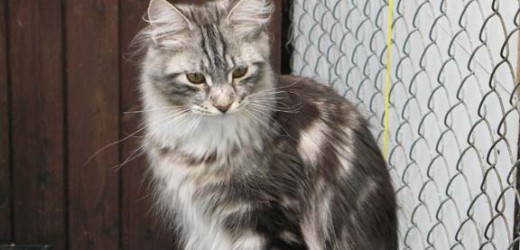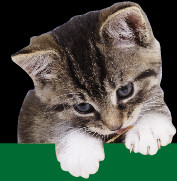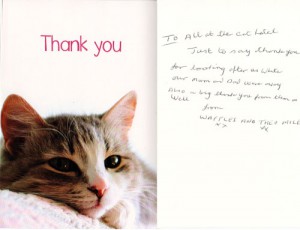How to Determine When To Contact Your Vet

How do determine when to get in touch with a vet
At Poynings Cat Boarding Hotel we monitor all our cats on a daily basis. Knowing your cat is the key to everything. It’s noticing the changes from their ‘normal’ to abnormal.
In your own home, it’s a little easier to spot changes during the winter. When the cat lives outside during the summer, you aren’t going to see faeces or changes in urine because they aren’t using their litter box. The most common indications that something is wrong are changes in eating habits, activity and coat quality.
WHAT TO LOOK FOR
Food
Cats are odd creatures when it comes to food. In the cattery the highlight of any day is food times. Everyone knows it’s food time because we try to keep the pattern the same for every day. At home, dining is a much more habitual process, so easy to spot changes. Backgrounds of cats play a part in how they eat. Rescue cats often have ‘food issues’. If there was a level of food scarcity when they were young or they had to fight for it, meal times can be frenetic, there are cats who will gorge, then throw it up making it unpalatable for other animals to scavenge. There are grazers, pickers and night eaters, but essentially a sudden lack of appetite is more noticeable – Sometimes kitty might just be feeling a bit icky, going off a particular brand or they’ve been dining out on raw voles and beetles, but in conjunction with other symptoms, it’s worth checking out.
Toilet
The major advantage that we have at the cattery is that we can always see the contents of the litter box. During the summer, you might not see any results for weeks if they prefer to go outside. However, if they are always eating the same food, the same amount at the same time there will be a ‘normal’ consistency, smell and colour so look out for changes. Straining is a bad sign, particularly when trying to urinate. Diarrhea is a very obvious change from the cat’s ‘normal’ and will result in dehydration if nothing else.
Grooming
Cats’ lifestyles range from living under hedges, covered in twigs and goosegrass to soaking up the sunshine from a radiator hammock. Their fur can be long or short, dense or smooth but again you need to spot any changes. At home you’re looking for a change in grooming, not as much time spent, an unkempt look, greasier pile or matts forming. Amongst other things this could mean a depression, an injury or arthritis … at the other end of the spectrum, there’s over-grooming – When a cat can’t stop licking a particular spot. We see cats who suddenly develop the habit of removing the fur at the base of their tails or turn up with bald bellies. There’s numerous reasons for these changes from particular mites, to fleas causing skin irritation, or indicating something below the skin is causing your cat concern. Or it could be a psychological reaction with no physical cause.
Sociability
It’s difficult for us to monitor changes in attitude in the cattery because it’s a place of safety, a cave of warmth and comfort. Obviously, if a normally placid cat becomes suddenly angry or starts peeing outside their litter tray, we assume that the cat has been perturbed by some change in his home environment – A new cat in the neighbourhood, a new addition such as a dog or baby in the house, or moving home. If your cat is ‘normally’ sitting on your lap when you sit down or watching you cook or playing with the tap water, that’s his ‘normal’. If you notice him being nervous or huddling in corners, there’s a good chance that there’s an underlying emotional or physical injury.
Walking Normally
When we injure a leg or more often a foot, the pain shows on our face with every step … A cat (and probably every other mammal) keeps going until it can no longer walk. A cat’s survival instinct will hide pain without showing any facial expression so look for a change in stride length, or a limping gait. A change in how a cat walks could be the result of an injury or in older cats the onset of arthritis.
SLOW TO SHOW PROBLEMS
A lot of symptoms are slow to appear and it’s easy to overlook specific conditions and not notice anything out of the ordinary until the condition has sufficiently progressed. Identifying the problems early will go a long way to find treatments that are more effective.
Respiratory problems and allergies
Cats have extremely delicate respiratory systems and will sneeze at environmental changes as often as we have hot dinners. Pollen, dust, any kind of particle and they’re off. However, unusual breathing and feline asthma are the two real symptoms when you need to alert the vet. Noisy breathing, open mouthed breathing or snoring are all worth checking out as abnormal behaviour.
Teeth and gums
Dental care is part and parcel of standard veterinary healthcare. All vets should be checking your cats mouth, teeth and gums on every visit. If your cat has bad breath, drops a lot of food while eating or drools when purring you should look at his mouth area. If you’re worried push back your cats cheek and check for redness and inflammation around the gums. Look for missing teeth or grey teeth, maybe there is an abcess or lumps – Cats do have teeth removed quite often, especially when heading for double figures with a lifetime of a soft food diets behind them.
Urinary & renal issues
Urinary tract infection affects a small number of cats annually. It increases probability with gender and age, with male cats being most susceptible. The symptoms are varied, but strong smelling urine, excessive water intake, not enough urine excreted are the easiest to spot – These conditions are easily managed and best caught at the early stages.
Fat Cats
By the time your cat gets to middle age, he’ll have started to take it easy and slip into blissful inactivity after every meal. If your cat puts on a significant amount of weight, he will do it slowly. If he does, then it’s a lot more difficult for him to lose it. Regular check ups at the vets will tell you during their well-being check up or annual booster examination whether they are overweight or not.
Arthritis
As in humans, arthritis can’t be cured, only alleviated. Inflamed joints causes the cat pain, so they move less or their gait changes. Handling them helps with diagnosis: they can nip if you touch, stroke or brush a tender area and they can be wary when being picked up or cuddled. At home look for slow cautious movements and some stiffness when moving or walking.
WHEN TO GET IMMEDIATE HELP
Severe bleeding, particularly from anywhere on the head, or from the backside
Shallow breathing or rapid breathing
Collapse or unconsciousness
Fits or convulsions
Obvious wounds, a bone protruding through the skin are caused by accidents
Shock – panting, shivering, vomiting, body cool to the touch, and the lips, gums and tongue may appear very pale and cold
At Poynings Cattery near Brighton all our staff are experienced and dedicated and will take the time to get to know your cat and ensure their health is their number one priority. Should a cat be showing unusual signs or symptoms we will contact their owner immediately and if necessary the vet. You can rest assured that when you leave your cat with us we will treat them as we would our own.
Call us now on 01273 857 539 to find out more about how we care for your cat during their holiday with us at Poynings Cat Bording Hotel near Brighton




